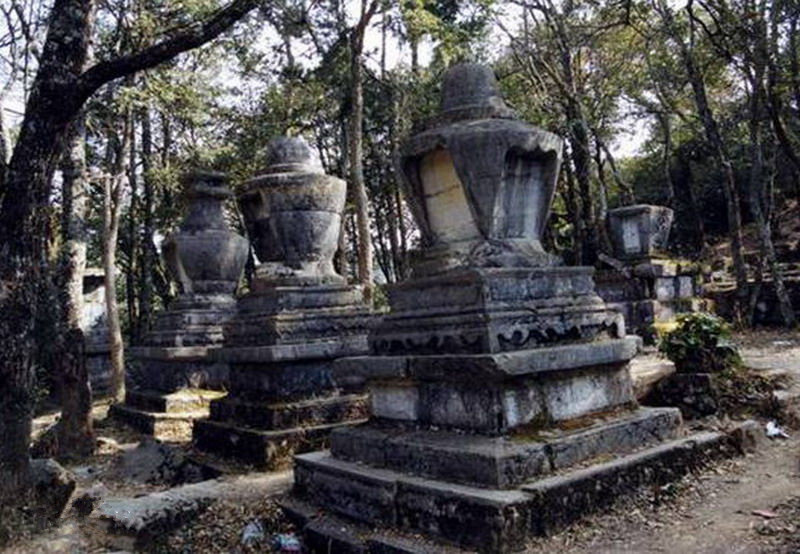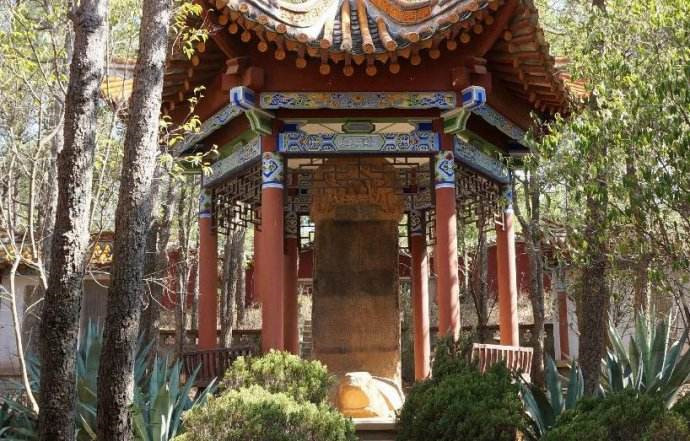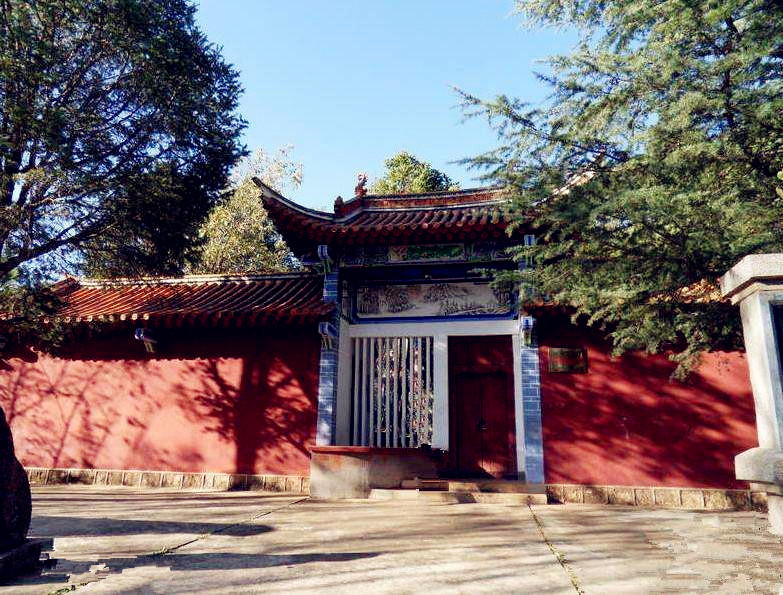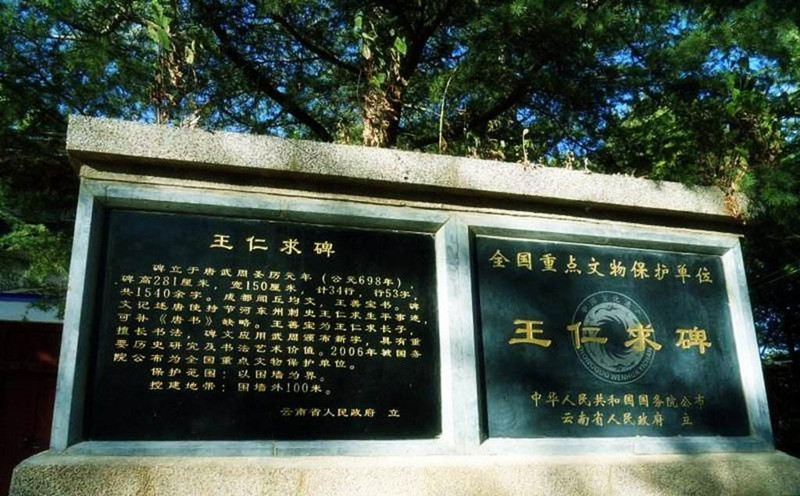
Tablet of Wang Renqiu in Anning City, Kunming
Overview
The Tablet of Wang Renqiu is located in Xiaoshizhuang Village (小石庄村), Mingyi River Township (鸣矣河乡), 20 kilometers south of Anning City (安宁市), Kunming (昆明), Yunnan Province (云南省). The tablet was erected by Wang Shanbao (王善宝) on October 10, 698 AD during the reign of Empress Wu Zetian (武则天). In 1992, to enhance its protection, a cemetery was built over 300 meters north of the tablet, and the tablet was relocated to a pavilion within this cemetery.
Physical Description
The Tablet of Wang Renqiu is made of shist stone, with a total height of 4.01 meters, a tablet body height of 2.03 meters, a width of 1.17 meters, and a thickness of 0.36 meters. The base is 2.6 meters long and 0.89 meters high. The ancient tablet, carved from sandstone, is 2.81 meters high and 1.50 meters wide, supported by a large stone turtle. The inscription was penned by the famous writer Lu Qiu Jun (闾丘均) from Chengdu (成都), and Wang Shanbao wrote the calligraphy, inscribing the title “Tablet of the Former Inspector of Hedong Prefecture” (大周故河东州刺史之碑). The inscription consists of 34 lines, each containing 53 characters, written in regular script. It includes a title with 10 characters, and features bas-reliefs of two dragons and a niche with a Buddha statue. The total word count is 1,638, including the title.
In 1961, the Tablet of Wang Renqiu was designated as one of the first provincial-level cultural relic protection units by the Yunnan Provincial People’s Government. On May 25, 2006, it was listed as a national key cultural relic protection unit by the State Council of the People’s Republic of China.
Location
- Geographical Location:
- Mingyi River Township (鸣矣河乡), Xiaoshizhuang Village (小石庄村), Anning City (安宁市), Yunnan Province (云南省).
- Historical Period: Tang Dynasty (唐).
- Protection Level: Sixth batch of national key cultural relic protection units.
- Approval Authority: State Council of the People’s Republic of China.
- Number: 6-0862-4-52.
Historical Background
In the first year of the Tang Dynasty (唐) under the reign of Emperor Gaozu (高祖), the Yao Prefecture (姚州) was established to unify the command against the struggles of various tribes resisting the Tibetan nobility. Later, Meng Jian (蒙俭), the inspector of Yangguazhou (阳瓜州), rebelled against the Tang, gathering tribal leaders from the Erhai (洱海) area to launch a major offensive against Yao Prefecture. The Tang appointed Wang Renqiu (王仁求) to quell this rebellion, which severely impacted the pro-Tibetan forces in the Erhai area. However, the Tang army suffered heavy losses and had to temporarily abandon Yao Prefecture.
In the first year of the Tang Dynasty’s Chui Gong (垂拱) era, under the advice of Wang Renqiu’s son, Wang Shanbao (王善宝), the Tang Dynasty reinstated Yao Prefecture and established seven towns with stationed troops, eventually driving away the Tibetan invading forces.
The Tablet of Wang Renqiu was erected by Wang Shanbao on October 10, 698 AD during the reign of Empress Wu Zetian.
In 1982, during a cultural relic survey in Anning County, patterned bricks were discovered in a gully 20 meters east of the Wang Renqiu family tomb. Due to soil erosion, a brick tomb seat was exposed on a cliff. Farmers took bricks to build walls, causing damage.
In March 1989, members from the Yunnan Provincial Institute of Cultural Relics and Archaeology, Kunming Municipal Cultural Heritage Committee, and Anning County Cultural Bureau conducted excavations at the Tablet of Wang Renqiu and the family tomb.
In 1992, to enhance protection, a cemetery was built 300 meters north of the tablet, and it was moved into a wooden hexagonal pavilion for preservation. Behind the pavilion, a replica of Wang Renqiu’s tomb was constructed, also with a pavilion. The cemetery is surrounded by a wall with an entrance facing southeast, flanked by restrooms and guard accommodations. About 20 meters in front of the entrance, there is a restored stone-carved beast, and a hexagonal pavilion is situated 20 meters across from the gate.
Architectural Layout
The Tablet of Wang Renqiu is made of shist stone, with a total height of 4.01 meters, a tablet body height of 2.03 meters, a width of 1.17 meters, and a thickness of 0.36 meters. The ancient tablet is carved from sandstone, measuring 2.81 meters in height and 1.50 meters in width, supported by a large stone turtle. The inscription, penned by Lu Qiu Jun, states “Tablet of the Former Inspector of Hedong Prefecture” (大周故河东州刺史之碑). The inscription consists of 34 lines, with each line varying between 17 and 51 characters, totaling 1,628 characters, plus the title of 10 characters, making a total of 1,638 characters.
Cultural Heritage
In the 52nd year of the Qianlong reign of the Qing Dynasty (清乾隆五十二年, 1787 AD), renowned epigrapher Wang Chang (王昶) served as the Governor of Yunnan. He dispatched people to seek out the tomb of Wang Renqiu, leading to the discovery of the tablet, prompting the reconstruction of the tomb for Wang and his son. A stone tablet titled “Record of the Reconstruction of the Tomb of Wang Renqiu, Inspector of Hedong Prefecture” (修唐河东州刺史王公墓记) was also erected beside the Tablet of Wang Renqiu.
Located about 200 meters north of the tablet is a gentle slope known as “Wangguan Fen” (王官坟), which contains the reconstructed tombs of Wang Renqiu and his son from the 53rd year of the Qianlong reign.
Historical Culture
Inscription Content
The inscription on the Tablet of Wang Renqiu praises his service as the inspector of Hedong Prefecture, during which he proposed the establishment of over 20 prefectures west of Yao Prefecture and managed their development. He also assisted the Tang generals in quelling the rebellion led by Meng Jian and the local chief He She, achieving military success. The inscription includes characters created during Wu Zetian’s reign. The establishment of Hedong Prefecture is not recorded in the New and Old Books of Tang, but it likely refers to the area around present-day Fengyi Town (凤仪镇), Dali City (大理市), situated between the territories of Xicuan Bai Miao and Yangguazhou. The historical facts recorded in the inscription supplement historical records and prove the Tang Dynasty’s governance and implementation of orders in the Yunnan frontier, reflecting Wang Renqiu’s loyalty to the Tang court.
Related Figures
- Wang Renqiu (王仁求): Year of birth unknown, hailing from Anning County (安宁郡), a prominent chief of the Xicuan Bai Miao. He held the position of commander of the military affairs of Hedong Prefecture and was also the inspector of Hedong. Despite being on the frontier, Wang Renqiu was concerned with the expansion of Tang territory. Around 662 AD, he suggested that the Tang Dynasty should establish counties in Yunnan due to the fertile land and abundant production. During the reign of Emperor Xianheng (咸亨), Meng Jian, the inspector of Yangguazhou, launched a military offensive against Yao Prefecture. Wang Renqiu bravely led his troops to fight for the Tang Dynasty. He died in the fifth year of Xianheng, at the age of 44. Twenty-four years after his death, his son Wang Shanbao buried him and erected the tablet. Wang Shanbao inherited his father’s position and gained the trust of the Tang court, serving as a guard in the capital.
- Wang Shanbao (王善宝): The eldest son of Wang Renqiu, served as a guard in the capital, later inheriting his father’s position. He held the title of General of Cloud Banner (云麾将军) and served as the left eagle guard in the Yang Wei general’s household, overseeing military affairs of Hedong Prefecture while concurrently serving as the inspector.
- Lu Qiu Jun (闾丘均): Year of birth and death unknown, from Chengdu, he served as a doctor during the Wu Zetian period. Afterward, he was demoted to a storage position in Xunzhou. He was later appointed as a record keeper in the Ninth Expedition of the Tang. Lu Qiu Jun was known for his literary talent and poetry, alongside poets like Du Shenyan (杜审言) and Chen Zi’ang (陈子昂). The inscription on the tablet was likely composed at the request of Wang Shanbao.
Cultural Value
The Tablet of Wang Renqiu, while written in honor of Wang Renqiu, addresses significant historical facts in Yunnan, providing valuable historical material. The inscription supplements historical records and demonstrates the Tang Dynasty’s governance and implementation of orders in the Yunnan frontier, reflecting Wang Renqiu’s loyalty to the Tang court. It serves as an essential piece of evidence for understanding Yunnan’s history during the Tang Dynasty.
Tourist Information
- Visiting Hours: Open daily from 8:00 AM to 5:00 PM.
- Ticket Price: Free entry.
- Transportation: Accessible by bus or taxi from Anning City.
- Nearby Attractions: Visitors can explore the scenic beauty of Mingyi River and other cultural relics in the vicinity.
The Tablet of Wang Renqiu is a significant cultural relic, illustrating the historical legacy of the Tang Dynasty in Yunnan and the loyalty of its officials. It serves as a testament to the region’s rich history and culture, attracting tourists and scholars interested in China’s historical narratives.





 7 Days GolfingTour
7 Days GolfingTour
 8 Days Group Tour
8 Days Group Tour
 8 Days Yunnan Tour
8 Days Yunnan Tour
 7 Days Shangri La Hiking
7 Days Shangri La Hiking
 11 Days Yunnan Tour
11 Days Yunnan Tour
 6 Days Yuanyang Terraces
6 Days Yuanyang Terraces
 11 Days Yunnan Tour
11 Days Yunnan Tour
 8 Days South Yunnan
8 Days South Yunnan
 7 Days Tea Tour
7 Days Tea Tour
 8 Days Muslim Tour
8 Days Muslim Tour
 12 Days Self-Driving
12 Days Self-Driving
 4 Days Haba Climbing
4 Days Haba Climbing
 Tiger Leaping Gorge
Tiger Leaping Gorge
 Stone Forest
Stone Forest
 Yunnan-Tibet
Yunnan-Tibet
 Hani Rice Terraces
Hani Rice Terraces
 Kunming
Kunming
 Lijiang
Lijiang
 Shangri-la
Shangri-la
 Dali
Dali
 XishuangBanna
XishuangBanna
 Honghe
Honghe
 Kunming
Kunming
 Lijiang
Lijiang
 Shangri-la
Shangri-la
 Yuanyang Rice Terraces
Yuanyang Rice Terraces
 Nujiang
Nujiang
 XishuangBanna
XishuangBanna
 Spring City Golf
Spring City Golf
 Snow Mountain Golf
Snow Mountain Golf
 Stone Mountain Golf
Stone Mountain Golf



















